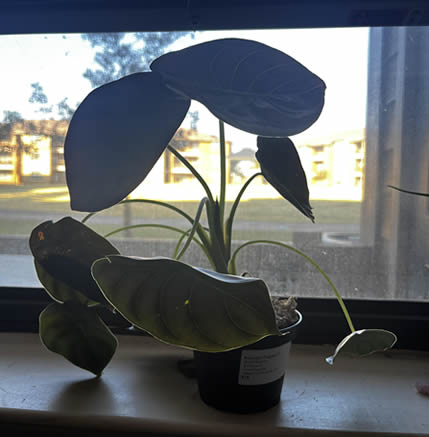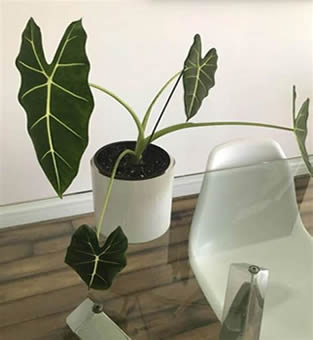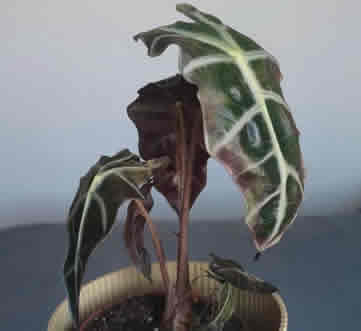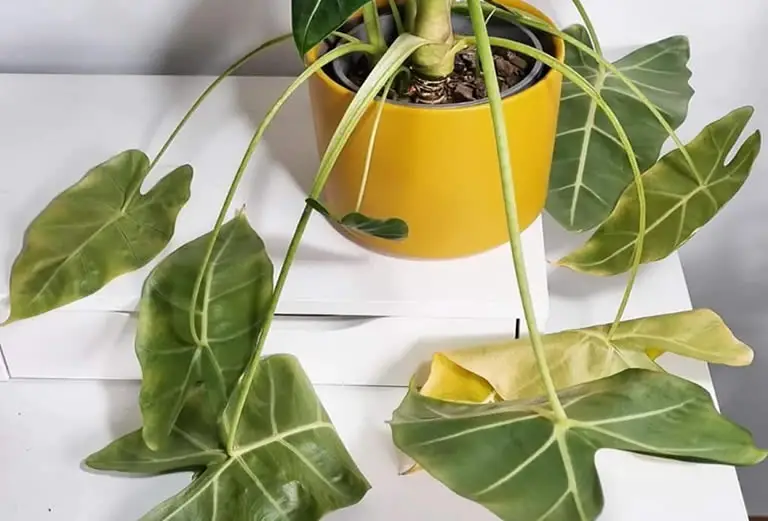Alocasias are among the most captivating houseplants out there—their dramatic leaves and striking silhouettes make them a standout in any collection. But they can be just as dramatic when something’s wrong. If you’re noticing your Alocasia leaves drooping, don’t worry. With the right care and a bit of troubleshooting, your plant can bounce back.
Let’s dive into the most common reasons your Alocasia might be drooping and what you can do to fix it.
Table of Contents
- Overwatering: The Most Common Cause of Drooping Leaves
- Underwatering: Easy to Fix But Still a Problem
- Low Humidity Can Stress Alocasias
- Low Light Slows Growth and Causes Sagging
- Temperature Swings and Drafts Cause Stress
- Pests Could Be Weakening Your Plant
- Dormancy: A Natural Reason for Drooping
- Final Thoughts
Overwatering: The Most Common Cause of Drooping Leaves
Despite their tropical roots, Alocasias don’t like wet feet.

Overwatering is a frequent issue and can be more damaging than underwatering.
What happens when an Alocasia is overwatered?
Soil that stays soggy deprives the roots of oxygen.
This causes the roots to weaken or rot, leaving your plant unable to absorb water properly.
The result?
Drooping leaves and declining health.
How to spot overwatering:
-
Soil stays wet for more than 5–7 days
-
General yellowing of lower leaves
-
Wet, brown leaf spots or blistering (edema)
-
A musty or rotten smell near the base
What increases the risk of overwatering?
-
Heavy, poorly-draining soil
-
Pots without drainage holes
-
Oversized pots that hold moisture too long
-
Low light or winter dormancy slowing water uptake
What to do:
-
Gently unpot your plant and check the roots
-
Remove any mushy, rotted sections
-
Repot into a chunky, well-draining soil mix
-
Water only when the top inch or two feels dry
Underwatering: Easy to Fix But Still a Problem
Alocasias are just as sensitive to underwatering as they are to overwatering.

Signs of underwatering:
-
Dry, compacted soil
-
Crispy brown leaf tips and edges
-
Smaller pots drying out within a day or two
-
Wilted or drooping leaves, especially during hot weather
What to do:
-
Water thoroughly and ensure your soil retains a little moisture without becoming soggy
-
Check if your plant is rootbound—this can cause rapid drying
-
Monitor frequently and adjust watering as needed
Low Humidity Can Stress Alocasias
As rainforest natives, Alocasias crave high humidity.
Dry indoor air—especially in winter—can cause drooping, curling, and browning of the leaf tips.
Signs of low humidity:
-
Leaves curling or drooping independently of the rest of the plant
-
Brown, dry leaf margins
-
Plant seems otherwise healthy but looks “tired”
How to raise humidity:
-
Use a room humidifier
-
Group plants together
-
Set the pot on a pebble tray with water
-
Move to a steamy room like a bathroom (with bright light)
Aim for humidity of 60% or higher. A digital hygrometer can help you monitor levels right next to your plant.
Low Light Slows Growth and Causes Sagging
Alocasias need bright, indirect light to stay upright and vigorous.

In lower light, growth slows, water use decreases, and the risk of drooping from moisture imbalances increases.
What to do:
-
Move your Alocasia near a bright window (east or west is ideal)
-
Use sheer curtains to diffuse intense sunlight
-
Supplement with a grow light in winter or low-light rooms
Remember: what works in summer may not be enough in winter.
Temperature Swings and Drafts Cause Stress
Alocasias thrive in consistent warmth.
Sudden cold drafts or hot air blasts (from heaters or vents) can cause immediate leaf droop.
Ideal temperature range: 60–82°F (15–28°C)
Avoid areas near exterior doors, windows, or HVAC vents.
If your plant is exposed to drafts, move it to a more stable spot.
Leaves may not bounce back, but new growth will appear once conditions improve.
Pests Could Be Weakening Your Plant
Alocasias are prone to pests like spider mites, aphids, and mealybugs.
These sap-sucking insects can drain your plant’s strength and cause drooping.
What to look for:
-
Yellow spotting
-
Sticky residue or webbing
-
Bugs hiding under leaves or along stems
How to treat it:
-
Spray with insecticidal soap or neem oil
-
Rinse the plant with lukewarm water to dislodge pests
-
Repeat treatments weekly until pests are gone
-
Isolate the plant from others during treatment
Dormancy: A Natural Reason for Drooping
Not every case of drooping is bad news. If your Alocasia is slowing down in the fall or winter, it may be going dormant.

This is completely normal.
What to expect:
-
Leaves may droop or die back entirely
-
Growth slows or stops for weeks or months
What to do during dormancy:
-
Reduce watering (let the top few inches dry out)
-
Keep the plant in a bright, warm spot
-
Don’t fertilize until new growth appears
Dormancy can last a few weeks or up to six months—patience is key!
Final Thoughts
Alocasias are expressive plants.
When their leaves droop, they’re telling you something isn’t right.
Most often, the issue is related to watering—either too much or too little—but other factors like light, humidity, and temperature also play a role.
The key is observation. Take a closer look at your plant, check its environment, and make small adjustments.
With a little care and attention, your Alocasia will be standing tall again in no time.
Let me know if you’d like this adapted into a care checklist or printable guide!
Related Articles
Alocasia Plant Care: Indoor & Outdoor Care Guide
Alocasia Water Guide. Watering Alocasia & Growing Alocasia In Water
Understanding Alocasia Dormancy: What It Is, Why It Happens, and How to Handle It
How to Keep Your Alocasia Wentii Thriving: Complete Care Guide
Alocasia Dragon Scale Care Guide: How to Keep This Jewel Alocasia Thriving
Why Are My Alocasia Leaves Turning Yellow? Causes, Fixes, and What to Do Next
Alocasia Frydek Care Guide: How to Keep Your Green Velvet Thriving

